CogAT Grade 2 Form 7 Level 8 Test Preparation Software
Visuprep provides online CogAT grade 2 test prep materials. The online prep tests help prepare for the CogAT® Form 7 Level 8 tests (taken by 2nd graders). Each 2nd grade CogAT prep test costs $20 for one year’s membership, and contains 154 questions. To help with CogAT practice and test preparation, each online test comes with explanations for (in addition to answers to) the test questions.
CogAT 2nd Grade Test Demo Computer Software
Note that you can expand (enlarge) the size of the text and images in the demo CogAT prep test software on a mobile or tablet by using pinch-to-zoom. Pinch-to-zoom is when you place your thumb and a finger close together on the screen and move them apart without lifting them from the screen. To reduce the size of the text and images in the CogAT test prep demo software, place your thumb and a finger a little distance apart on the screen and move them toward each other without lifting them from the screen.
The demo test below has answers and explanations immediately after each question.
CogAT Form 7 Level 8 (Grade 2) Demo (Untimed)
The demo test below has answers and explanations at the end of the test.
A pdf file of the sample questions in the CogAT demo prep test, together with the answers, is available by clicking on the link below:
Visuprep CogAT Prep Test Form 7 Level 8 Grade 2 Sample Questions PDF
Videos on How to Solve CogAT Paper Folding & Figure Matrices Questions
Visuprep’s CogAT software contains written explanations for the questions.
Below, we have provided videos (in English and Spanish) on how to solve a CogAT paper folding and a CogAT Figure Matrices question.
English Version
Spanish Version
What is the CogAT®?
The CogAT (Cognitive Abilities Test) is a cognitive ability test that is often used to identify gifted and talented children for entrance into school accelerated and gifted and talented programs. CogAT tests include test batteries with verbal, quantitative, or nonverbal items.
A custom form of the CogAT® test (known as the FxAT™ or Fairfax Abilities Test™) is administered in grade 2 in Fairfax County, Virginia, to determine entrance into the Advanced Academic Programs (AAP) in Fairfax County, Virginia.
There are different editions (known as forms) and different levels of the CogAT test for different grades.
The CogAT Form 7 test has three sections (known as batteries):
- Verbal
- Quantitative
- Nonverbal
Each of these batteries has three question types (subtests) as shown below:
Verbal Battery Subtests
Grades K, 1 & 2 contain the following verbal battery subtests:
- Picture Analogies
- Sentence Completion
- Picture Classification
Grades 3-12 contain the following verbal battery subtests:
- Verbal Analogies
- Sentence Completion
- Verbal Classification
Quantitative Battery Subtests
- Number Analogies
- Number Series
- Number Puzzles
Nonverbal Battery Subtests
- Figure Matrices
- Paper Folding
- Figure Classification
There are ten levels of CogAT test, depending on a student’s grade level. The ten levels, their associated grades, the number of questions per test and the test times are shown below:
Level 5/6 (Kindergarten)
Total Number of Questions: 118
Test Time: 112 Minutes
Number of Questions Per Subtest
Verbal Battery:
- Picture Analogies – 14
- Sentence Completion – 14
- Picture Classification – 14
Quantitative Battery:
- Number Analogies – 14
- Number Puzzles – 10
- Number Series – 14
Nonverbal Battery:
- Figure Matrices – 14
- Paper Folding – 10
- Figure Classification – 14
Level 7 (Grade 1)
Total Number of Questions: 136
Test Time: 112 Minutes
Number of Questions Per Subtest
Verbal Battery:
- Picture Analogies – 16
- Sentence Completion – 16
- Picture Classification – 16
Quantitative Battery:
- Number Analogies – 16
- Number Puzzles – 12
- Number Series – 16
Nonverbal Battery:
- Figure Matrices – 16
- Paper Folding – 12
- Figure Classification – 16
Level 8 (Grade 2)
Total Number of Questions: 154
Test Time: 122 Minutes
Number of Questions Per Subtest
Verbal Battery:
- Picture Analogies – 18
- Sentence Completion – 18
- Picture Classification – 18
Quantitative Battery:
- Number Analogies – 18
- Number Puzzles – 14
- Number Series – 18
Nonverbal Battery:
- Figure Matrices – 18
- Paper Folding – 14
- Figure Classification – 18
Level 9 (Grade 3)
Total Number of Questions: 170
Test Time: 90 Minutes
Number of Questions Per Subtest
Verbal Battery:
- Verbal Analogies – 22
- Sentence Completion – 20
- Verbal Classification – 20
Quantitative Battery:
- Number Analogies – 18
- Number Puzzles – 16
- Number Series – 18
Nonverbal Battery:
- Figure Matrices – 20
- Paper Folding – 16
- Figure Classification – 20
Level 10 (Grade 4)
Total Number of Questions: 176
Test Time: 90 Minutes
Number of Questions Per Subtest
Verbal Battery:
- Verbal Analogies – 24
- Sentence Completion – 20
- Verbal Classification – 20
Quantitative Battery:
- Number Analogies – 18
- Number Puzzles – 16
- Number Series – 18
Nonverbal Battery:
- Figure Matrices – 22
- Paper Folding – 16
- Figure Classification – 22
Level 11 (Grade 5)
Total Number of Questions: 176
Test Time: 90 Minutes
Number of Questions Per Subtest
Verbal Battery:
- Verbal Analogies – 24
- Sentence Completion – 20
- Verbal Classification – 20
Quantitative Battery:
- Number Analogies – 18
- Number Puzzles – 16
- Number Series – 18
Nonverbal Battery:
- Figure Matrices – 22
- Paper Folding – 16
- Figure Classification – 22
Level 12 (Grade 6)
Total Number of Questions: 176
Test Time: 90 Minutes
Number of Questions Per Subtest
Verbal Battery:
- Verbal Analogies – 24
- Sentence Completion – 20
- Verbal Classification – 20
Quantitative Battery:
- Number Analogies – 18
- Number Puzzles – 16
- Number Series – 18
Nonverbal Battery:
- Figure Matrices – 22
- Paper Folding – 16
- Figure Classification – 22
Level 13/14 (Grades 7 & 8)
Total Number of Questions: 176
Test Time: 90 Minutes
Number of Questions Per Subtest
Verbal Battery:
- Verbal Analogies – 24
- Sentence Completion – 20
- Verbal Classification – 20
Quantitative Battery:
- Number Analogies – 18
- Number Puzzles – 16
- Number Series – 18
Nonverbal Battery:
- Figure Matrices – 22
- Paper Folding – 16
- Figure Classification – 22
Level 15/16 (Grades 9 & 10)
Total Number of Questions: 176
Test Time: 90 Minutes
Number of Questions Per Subtest
Verbal Battery:
- Verbal Analogies – 24
- Sentence Completion – 20
- Verbal Classification – 20
Quantitative Battery:
- Number Analogies – 18
- Number Puzzles – 16
- Number Series – 18
Nonverbal Battery:
- Figure Matrices – 22
- Paper Folding – 16
- Figure Classification – 22
Level 17/18 (Grades 11 & 12)
Total Number of Questions: 176
Test Time: 90 Minutes
Number of Questions Per Subtest
Verbal Battery:
- Verbal Analogies – 24
- Sentence Completion – 20
- Verbal Classification – 20
Quantitative Battery:
- Number Analogies – 18
- Number Puzzles – 16
- Number Series – 18
Nonverbal Battery:
- Figure Matrices – 22
- Paper Folding – 16
- Figure Classification – 22
The sample questions that appear in our demo CogAT prep test software are shown below.
Verbal Battery
The pictures on the top row are related. Which answer should go in the box with the question mark so that the pictures on the bottom row are related in the same way as the pictures on the top row?
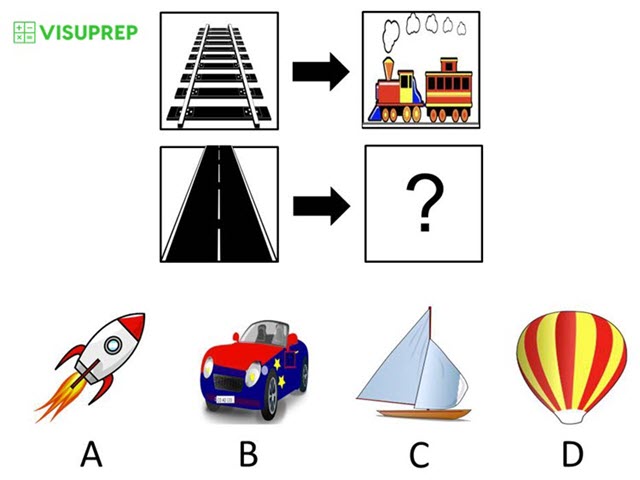
Track is to train as road is to car. Trains travel on tracks and cars travel on roads.

Which one is best for storing jewelry?
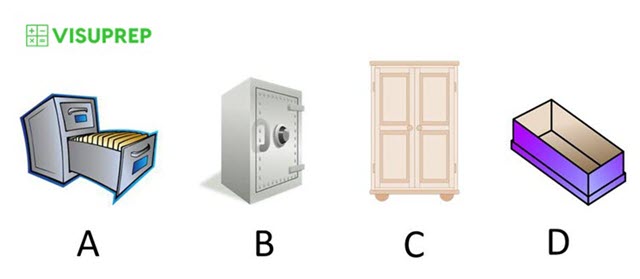
Safe

Which picture is most similar to the top three pictures?
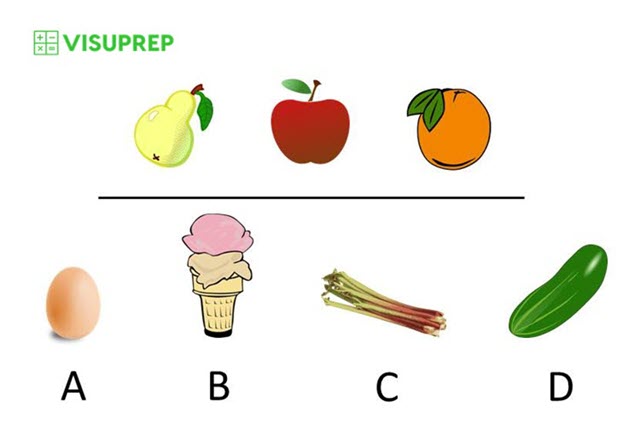
Cucumber
Classification: Fruits
The top three pictures are fruits, and a cucumber is a fruit. Rhubarb is a vegetable.

Quantitative Battery
The pictures on the top row are related. Which answer should go in the box with the question mark so that the pictures on the bottom row are related in the same way as the pictures on the top row?
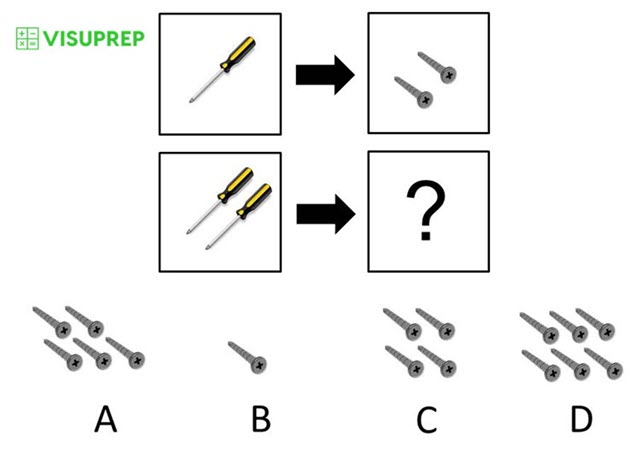
Two screws for each screwdriver.

Which answer contains the number which should replace the question mark to make the equation correct?
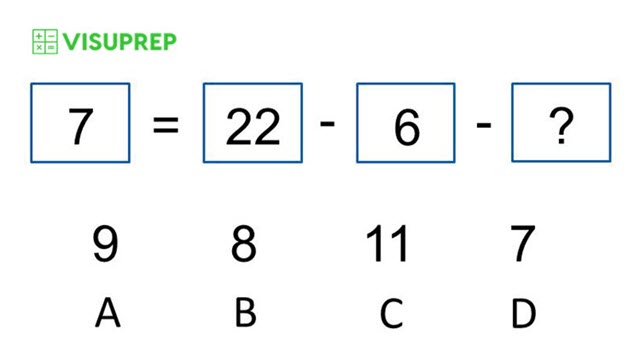
Note that in some regions, level 8 (grade 2) number puzzle questions may take the train form shown below rather than the equation form shown above. Visuprep level 8 CogAT tests use the equation form shown above rather than the train form. We have followed the example of Mercer Publishing, the originator of CogAT®, who use the equation form for level 8 prep.
A train form question would be something like:
Which train car should replace the car with a question mark so that the trains on the top row have an equal number of oranges?
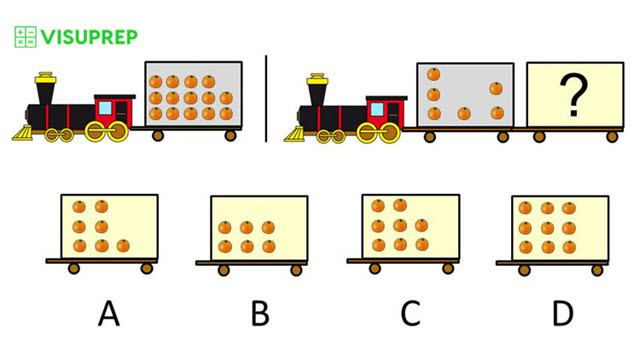
The answer is (C).
This is because the first train on the top row has 14 oranges and the second train has 6 oranges in the gray car. So the number of oranges in the car with a question mark must be the number which when added to 6 makes 14. That number is 8, and car (C) has 8 oranges, so the answer is (C).
22 – 6 = 16
so we can rewrite
7 = 22 – 6 – ? as
7 = 16 – ?
so we need to find the number which when subtracted from 16 gives the answer 7
(which is the same as the number which when added to 7 gives the answer 16).
The number is 9.

The picture below shows an abacus that is missing the last rod. Look for a rule or pattern used in the first five rods to determine the number of beads that should go on the missing rod. Which answer contains the correct number of beads for the missing rod?
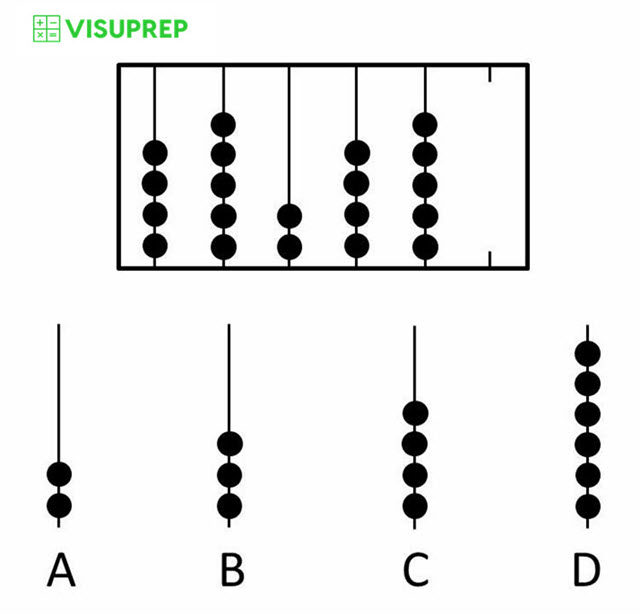
The first three numbers are repeated.

Nonverbal Battery
The figures on the top row are related. Which answer should go in the box with the question mark so that the figures on the bottom row are related in the same way as the figures on the top row?
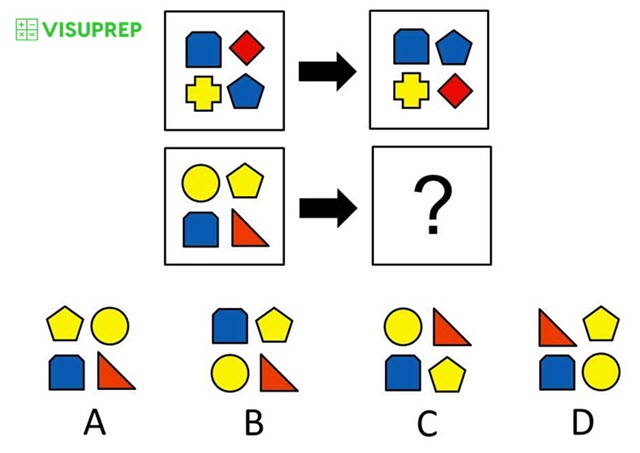
Reverse the order of the shapes in the second column.

The pictures on the top row show a square piece of paper being folded and then the folded paper is hole-punched. Choose the answer from the bottom row that shows how the folded paper with holes will look when it is unfolded.
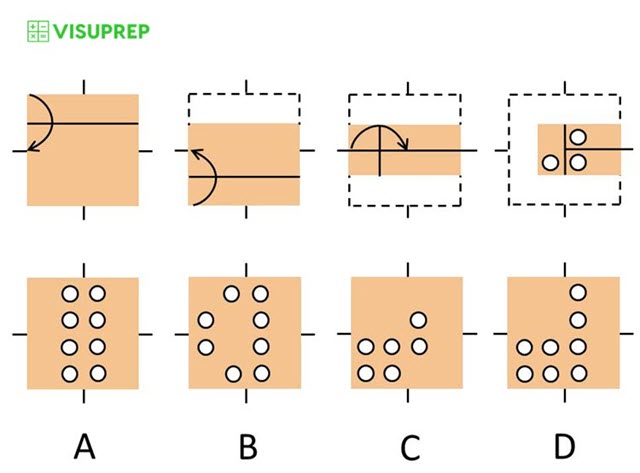

The pictures above show an orange piece of paper with small lines at the center of each side of the paper. There are arrows indicating the direction in which the paper is folded about a fold line (which is indicated by a black line which bisects the arrow). The white areas inside the dashed lines represent empty space which was occupied by the orange paper before it was folded.
In this question, the paper is folded three times. A fold is made from top to center (creating two layers of paper, one on top of the other). Another fold is then made from bottom to center (creating two layers of paper, one on top of the other). A fold is then made from left to center (creating four layers of paper since two layers are folded over two layers). So there is now one portion of folded paper made up of four layers and the rest of the folded paper is made up of two layers. One hole is then punched through the folded four layers of paper and two holes are punched through the folded two layers of paper. This means that the number of holes when the folded four layers of paper is unfolded will be 4 i.e. 1 hole for each layer, and the number of holes when the folded two layers of paper is unfolded will be 4 i.e. 2 holes for each layer. Therefore the total number of holes when the paper is unfolded will be 4 + 4 = 8. This means you can rule out any answer that does not have 8 holes. Therefore, you can rule out answer C since it has 6 holes. So the answer must be either A, B or D.
To find where the holes will be when the paper is unfolded, you need to work backward from the folded paper containing the punched holes (i.e. the fourth picture on the top row of the question).
The third picture on the top row of the question shows the third fold operation (i.e. a fold from left to center). To unfold the paper (or undo the fold), you need to unfold in the opposite direction (i.e. from center to left).
The black arrow on the picture shown below on the left shows the direction in which the paper needs to be unfolded (i.e. from center to left). The green arrow points to the fold line (i.e. the line about which the paper has been folded and about which the paper needs to be unfolded).
The picture on the right below shows the result of unfolding the paper. Note that when you unfold the paper, any holes on the folded paper are reflected in the fold line.
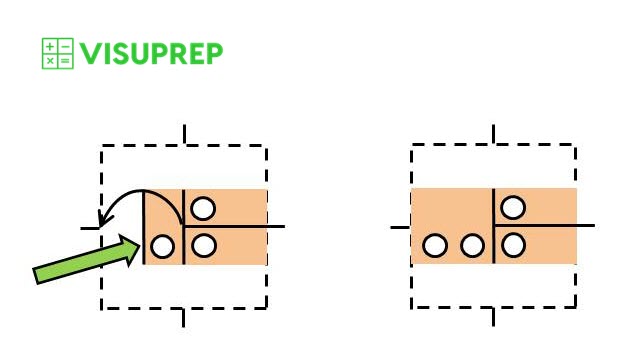
Next, you need to unfold (or undo) the second fold, which was a fold from bottom to center as shown in the second picture on the top row of the question. To unfold the paper (or undo the fold), you need to unfold in the opposite direction (i.e. from center to bottom).
The black arrow on the picture shown below on the left shows the direction in which the paper needs to be unfolded (i.e. from center to bottom). The green arrow points to the fold line (i.e. the line about which the paper has been folded and about which the paper needs to be unfolded).
The picture on the right below shows the result of unfolding the paper. Note that when you unfold the paper, any holes on the folded paper are reflected in the fold line.
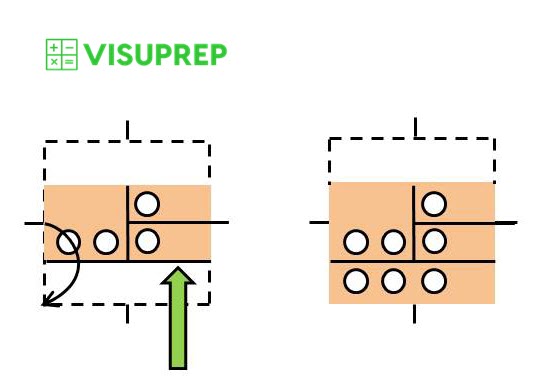
Next, you need to unfold (or undo) the first fold, which was a fold from top to center as shown in the first picture on the top row of the question. To unfold the paper (or undo the fold), you need to unfold in the opposite direction (i.e. from center to top).
The black arrow on the picture shown below on the left shows the direction in which the paper needs to be unfolded (i.e. from center to top). The green arrow points to the fold line (i.e. the line about which the paper has been folded and about which the paper needs to be unfolded).
The picture on the right below shows the result of unfolding the paper. Note that when you unfold the paper, any holes on the folded paper are reflected in the fold line.
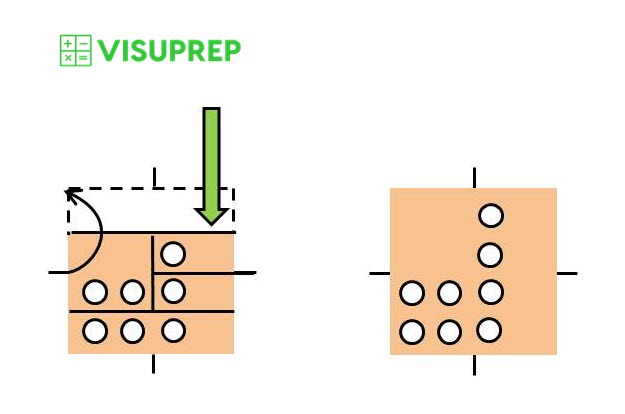
Which figure is most similar to the top three figures?
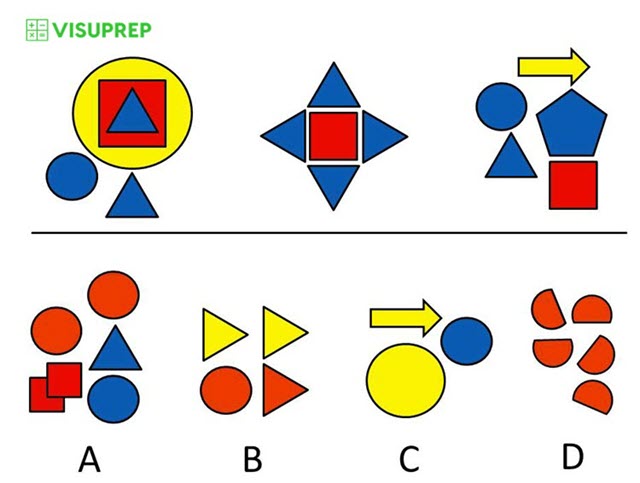
Each of the top figures consists of 5 shapes. The answer also has 5 shapes.

Cognitive Abilities Test™ (CogAT®) is a registered trademark of Riverside Publishing, a Houghton Mifflin Company, or its affiliate(s), or their licensors.
Fairfax Abilities Test™ (FxAT™ Test) is a trademark of Fairfax County Public Schools, or their affiliate(s), or their licensors.
Visuteach and its website, visuprep.com, are not affiliated with nor authorized, sponsored or otherwise approved by Houghton Mifflin or Fairfax County Public Schools.







